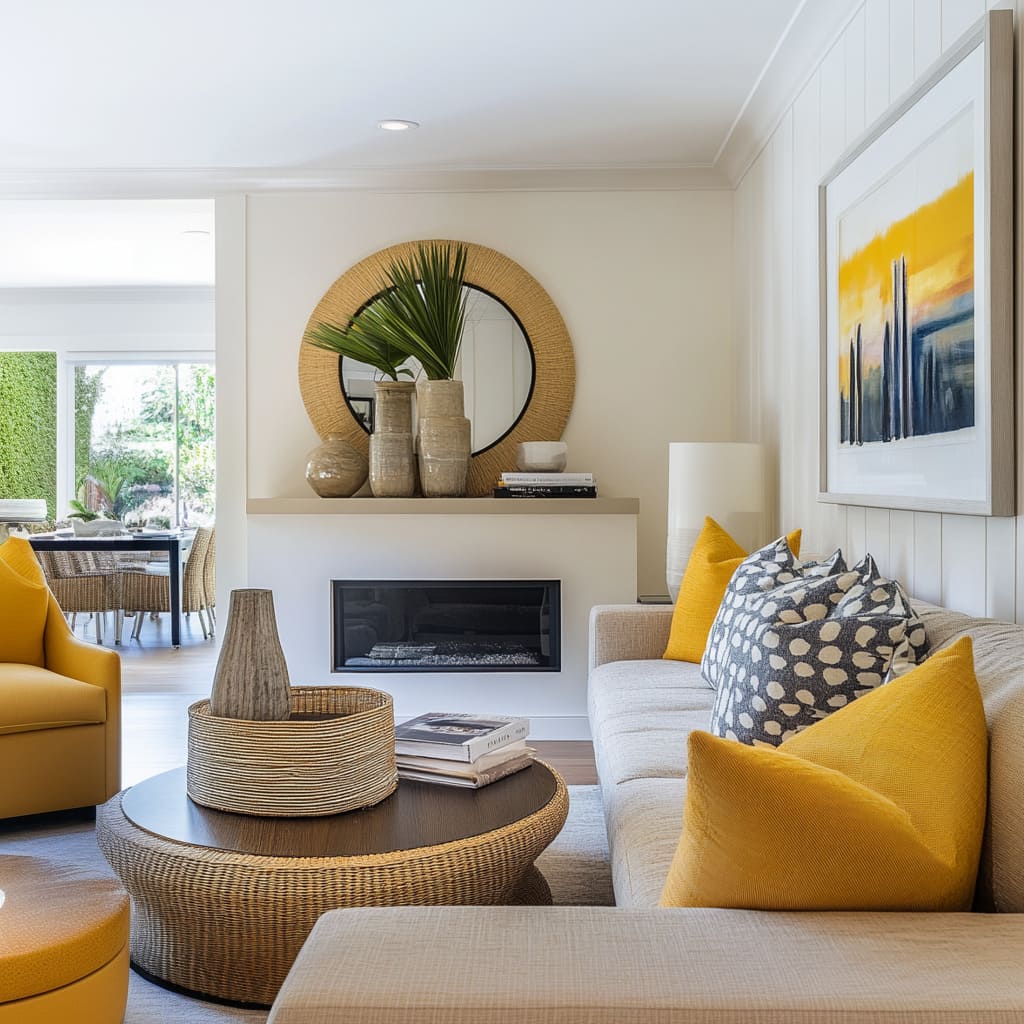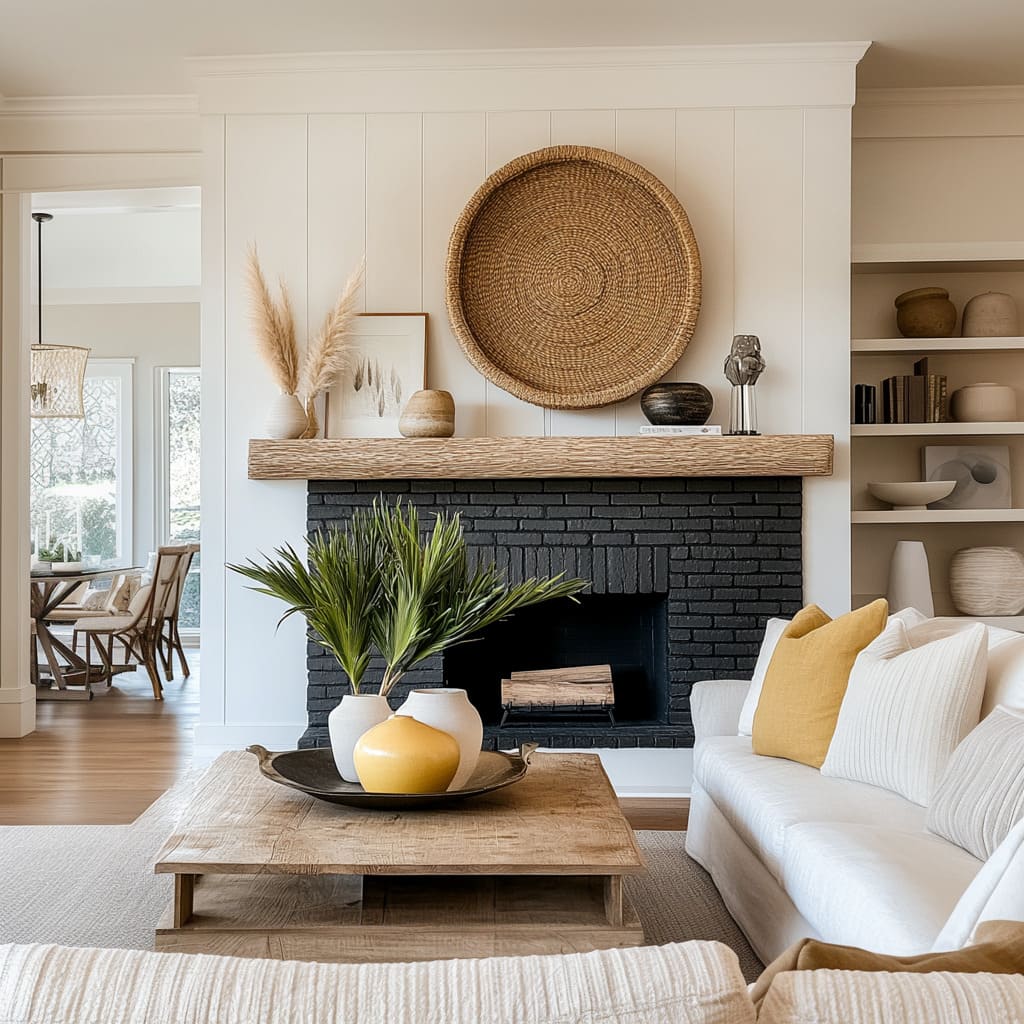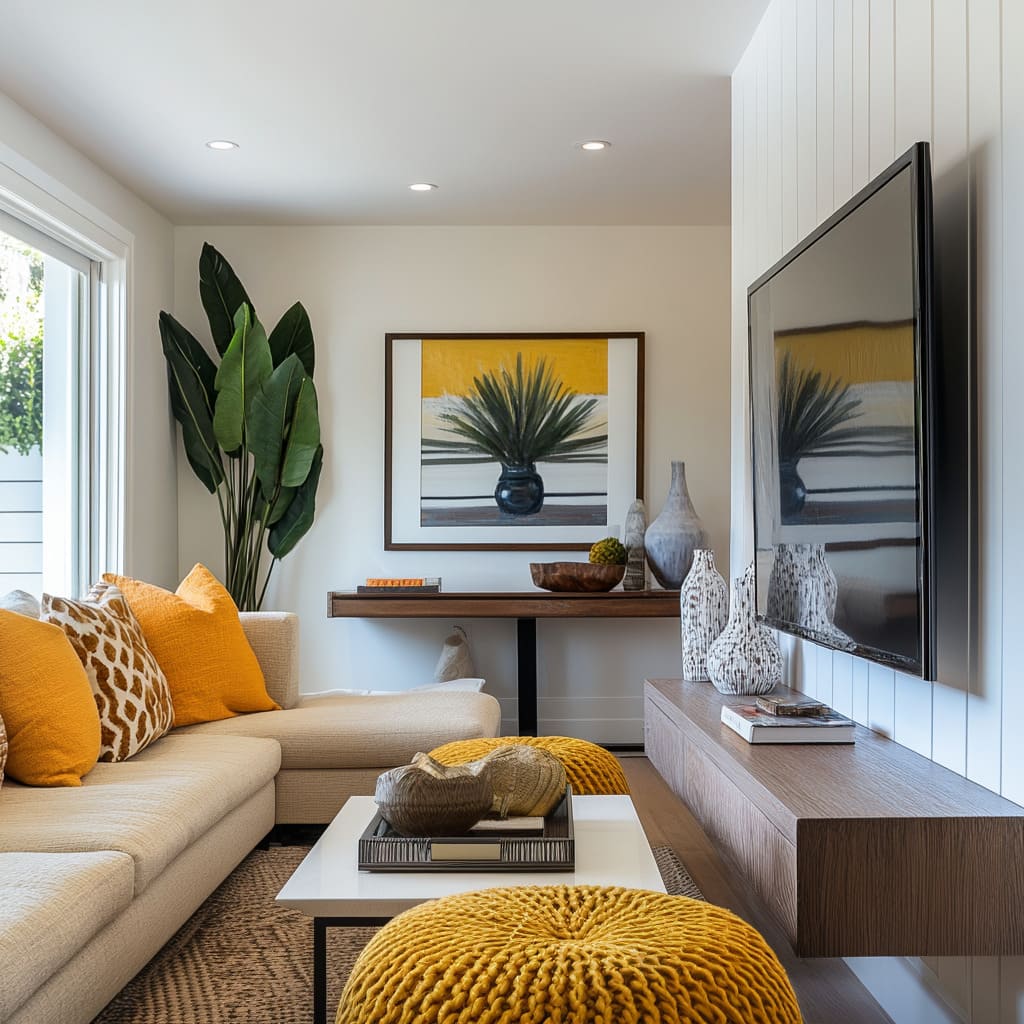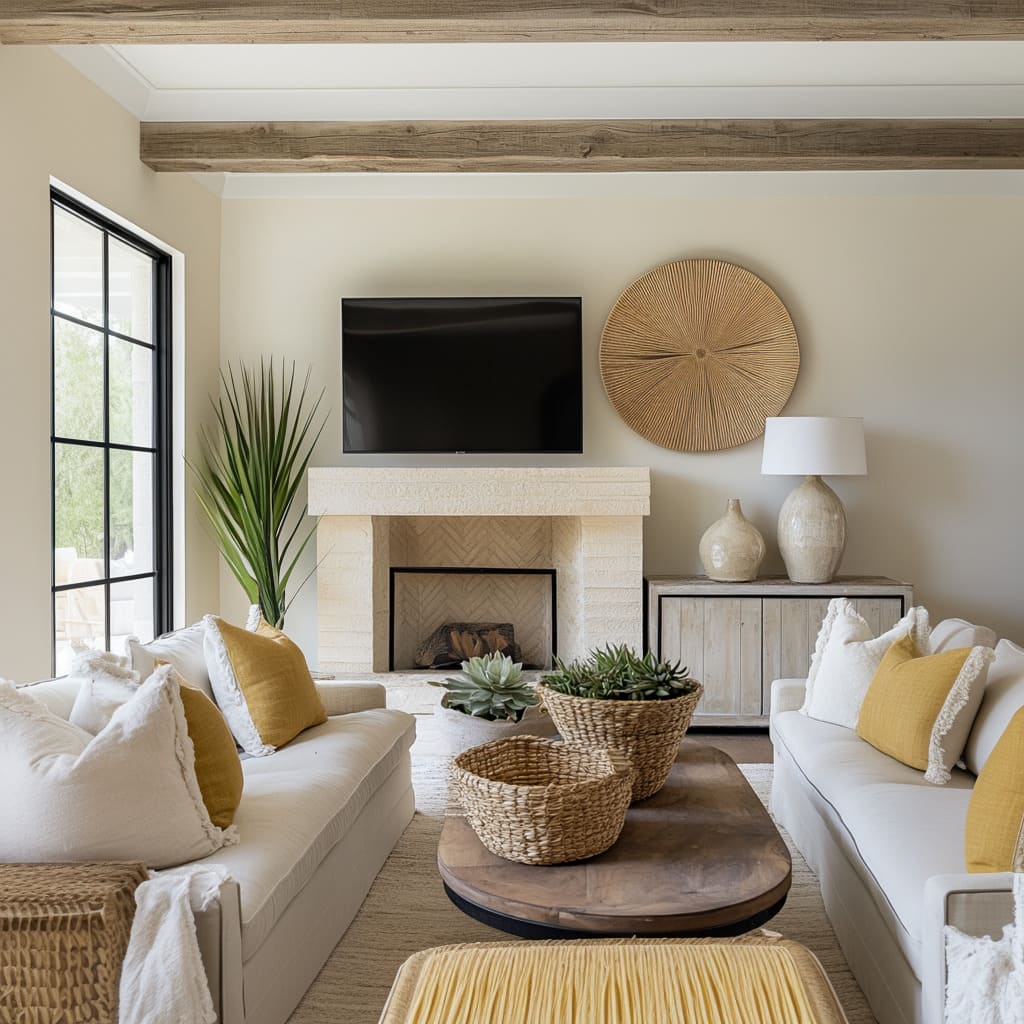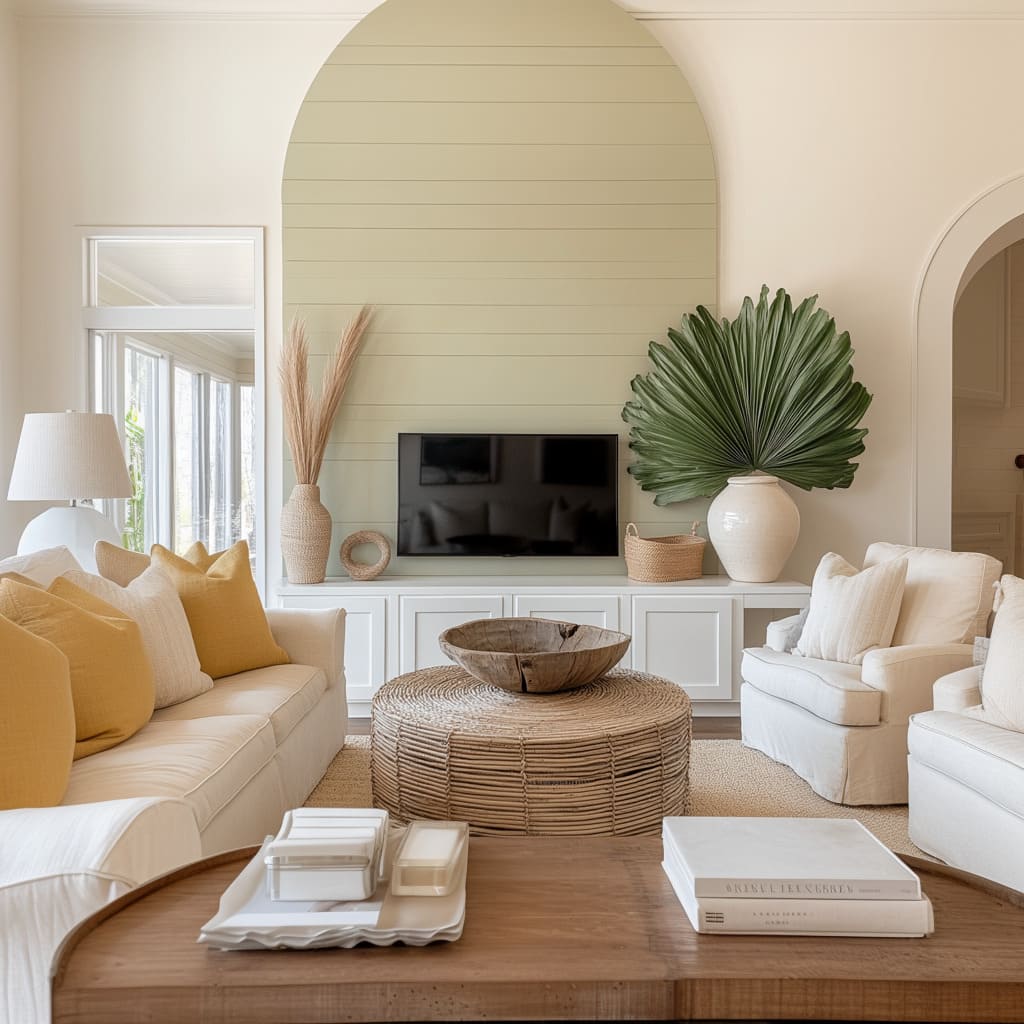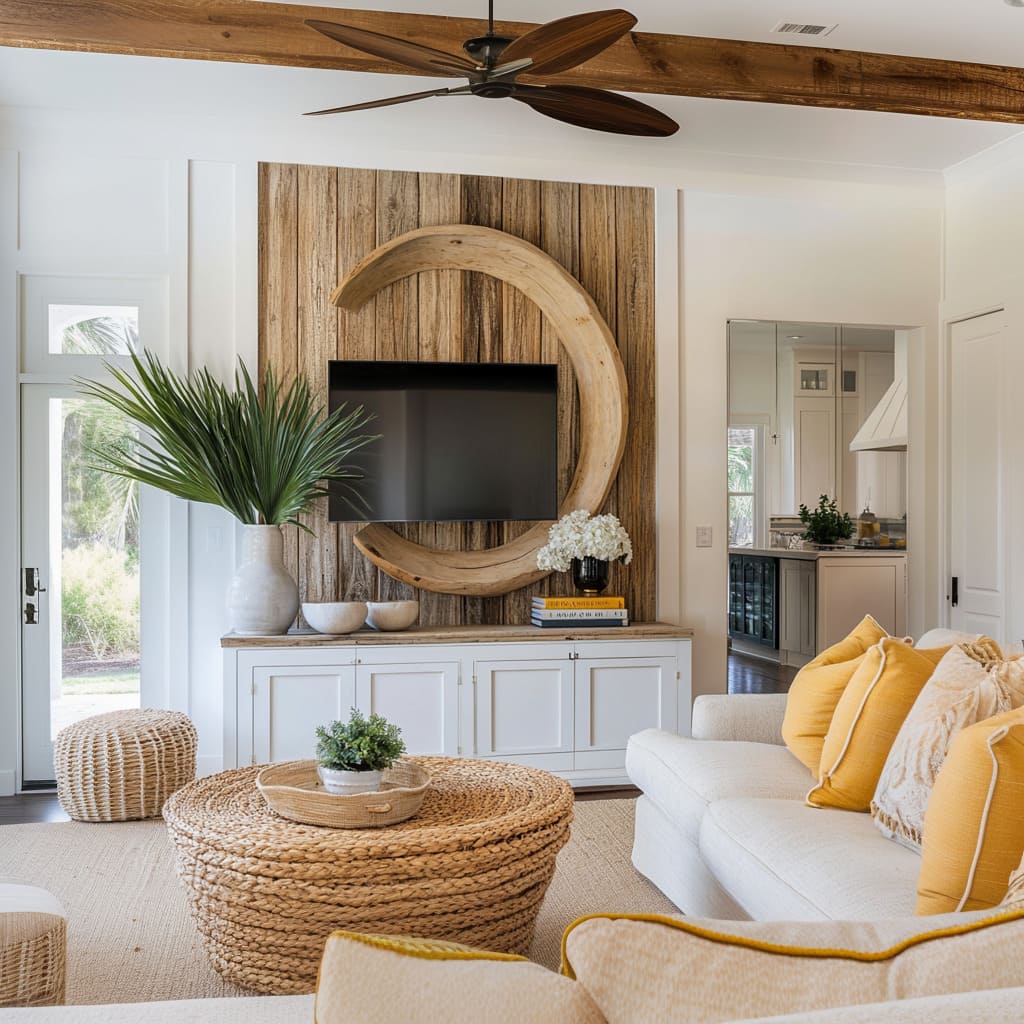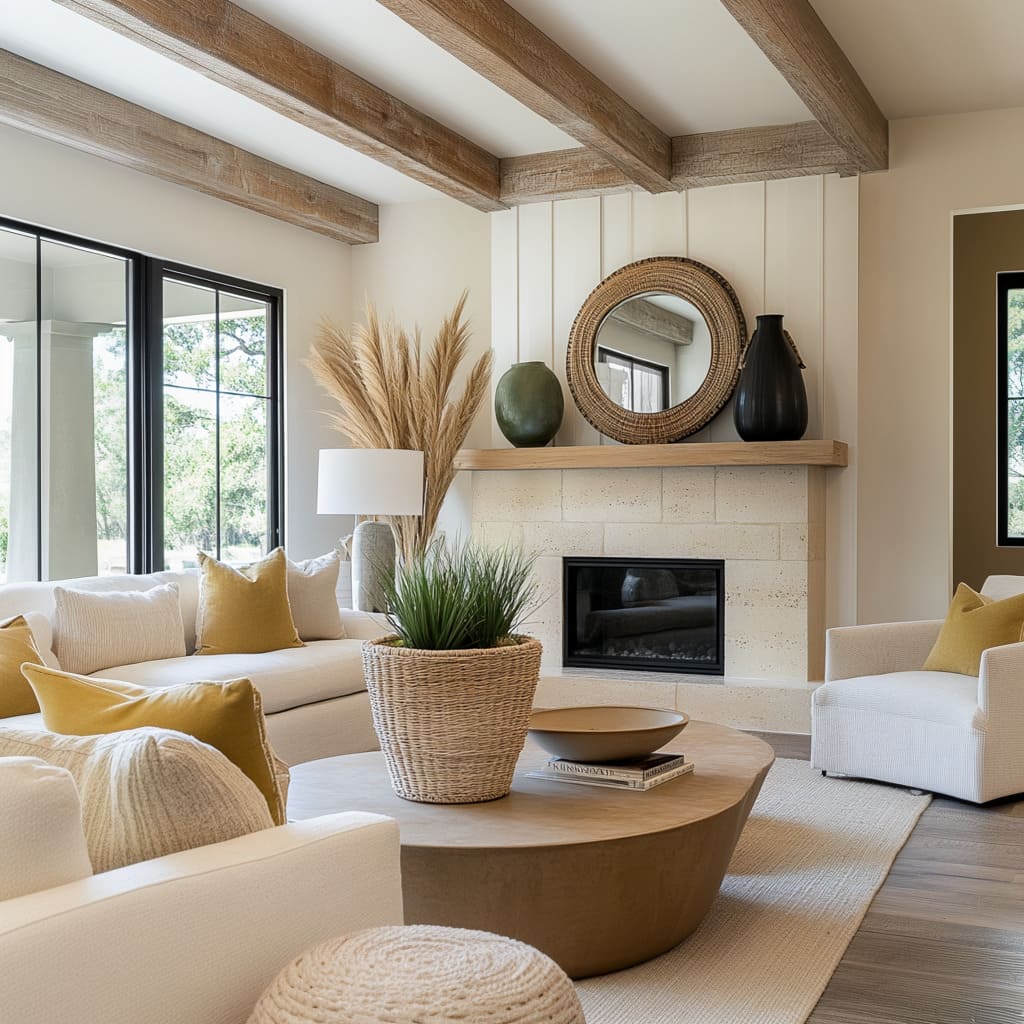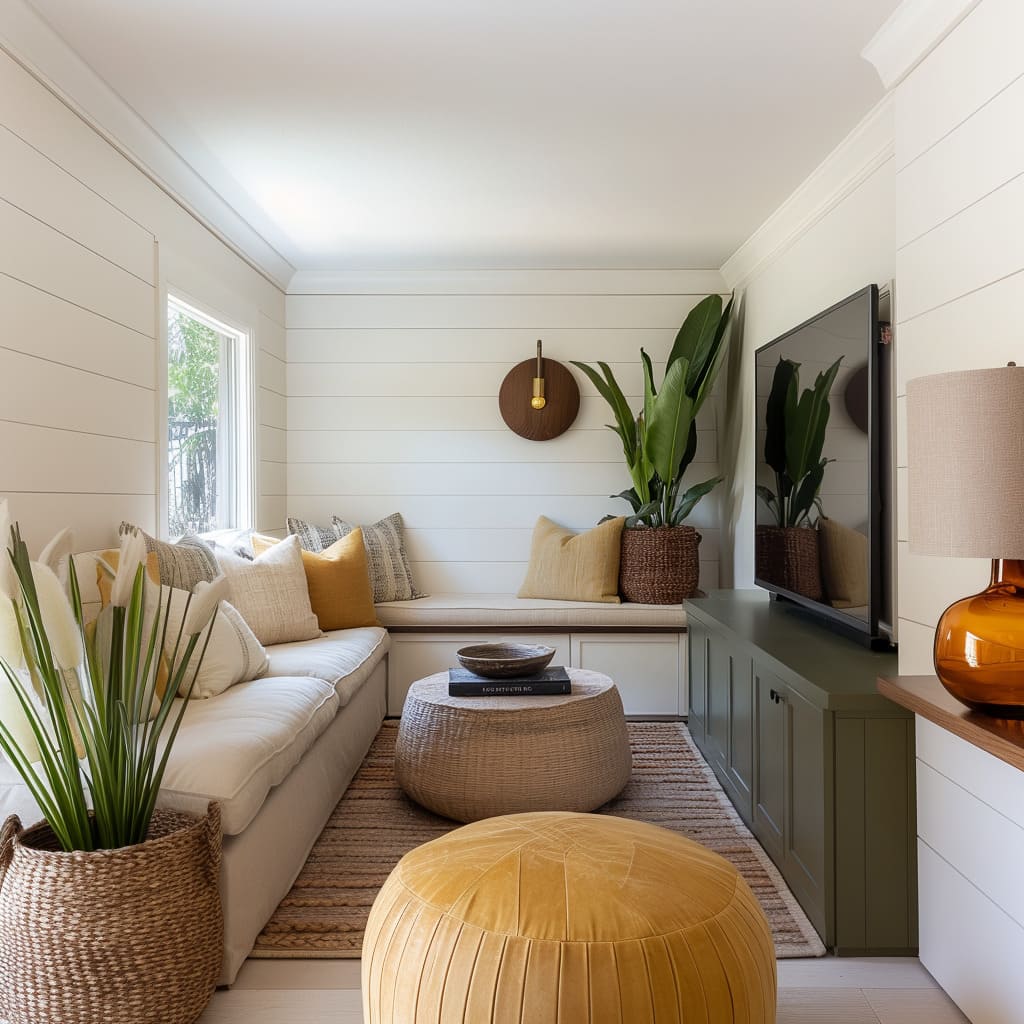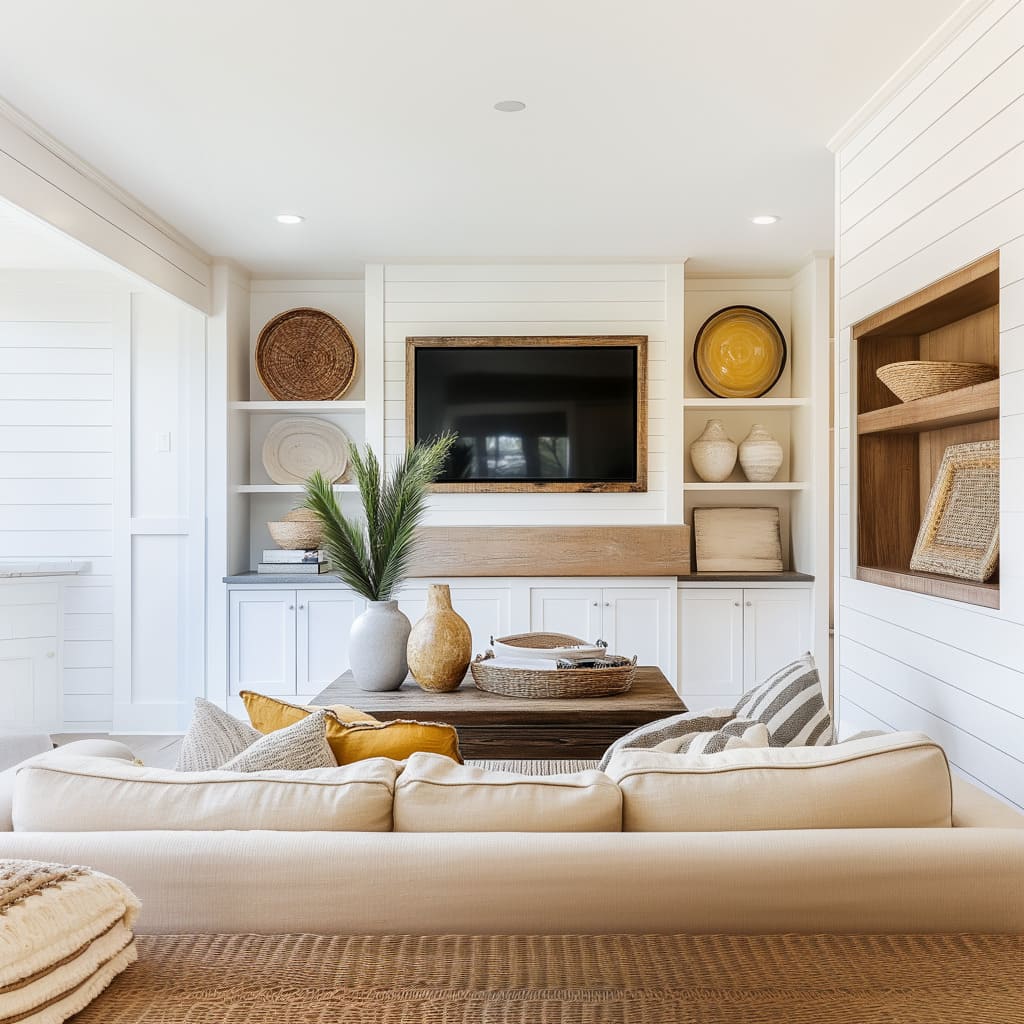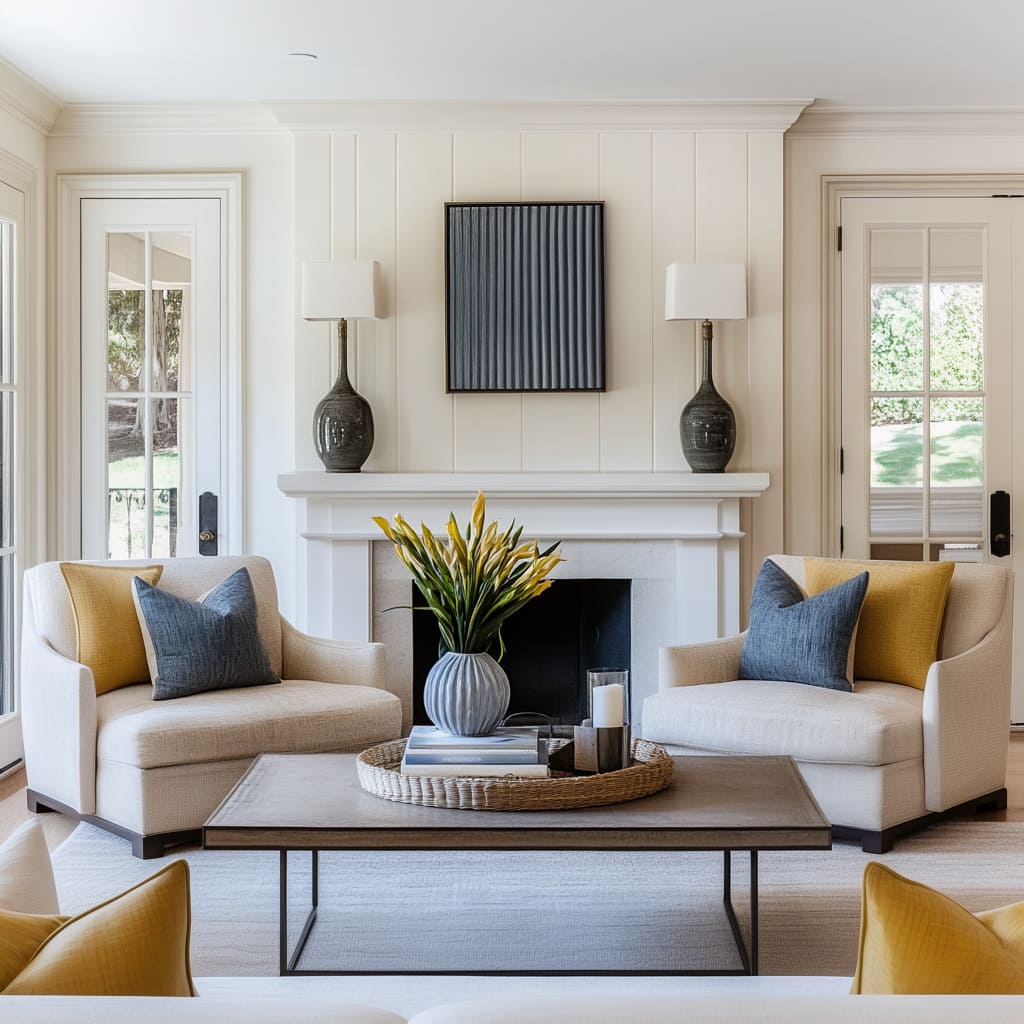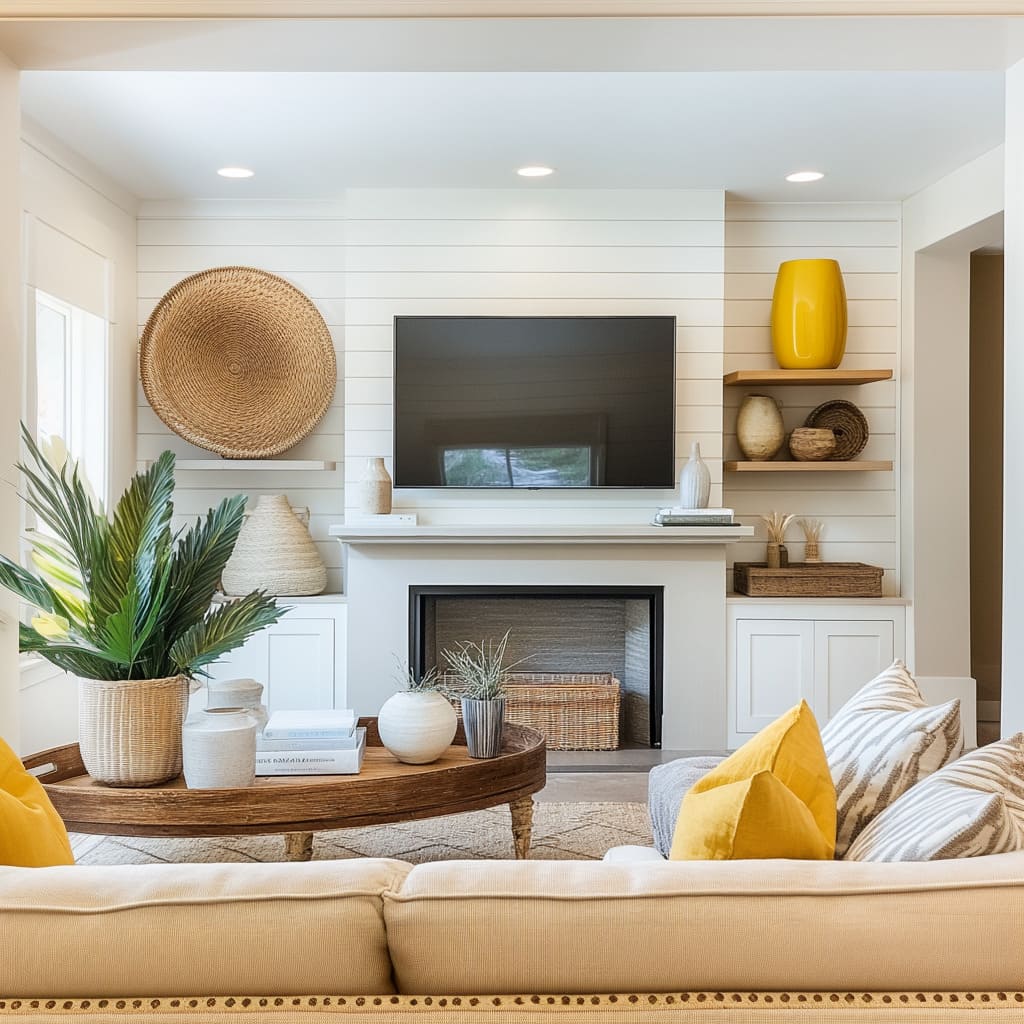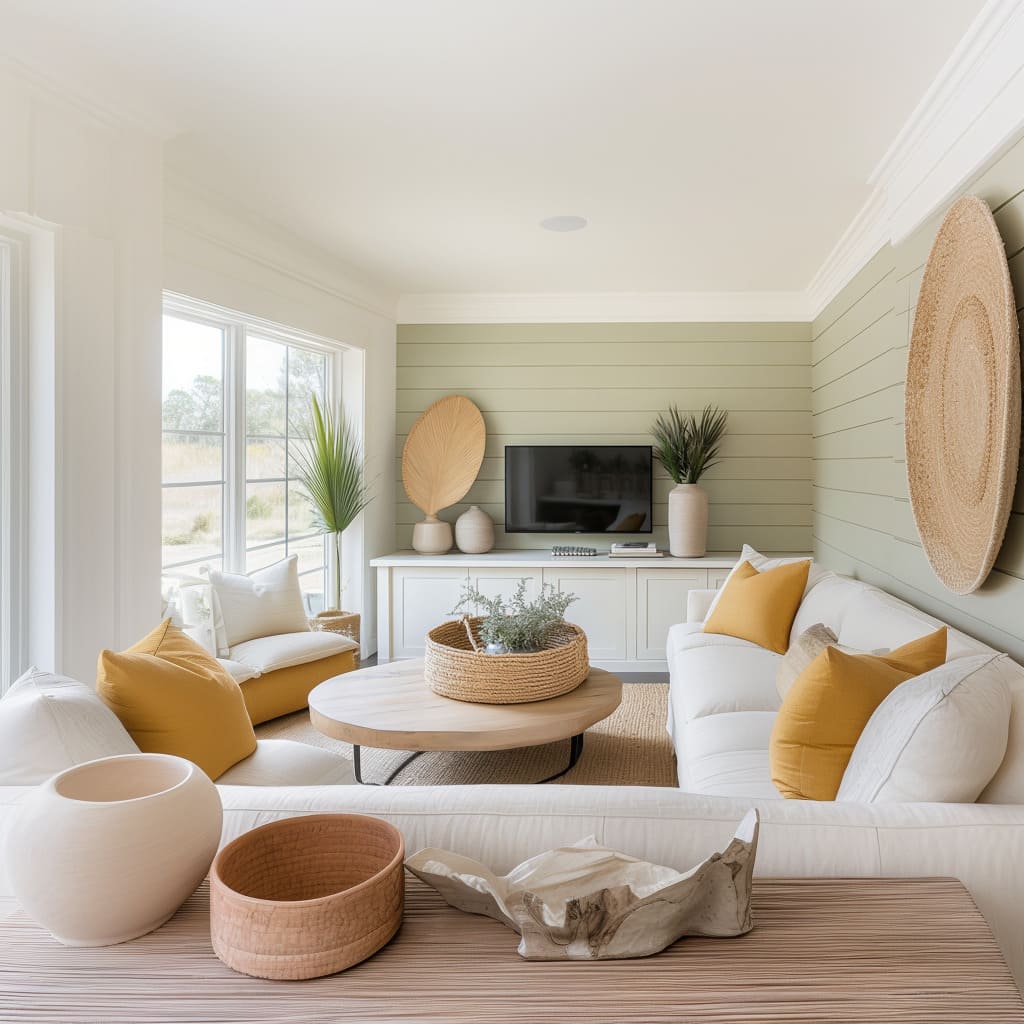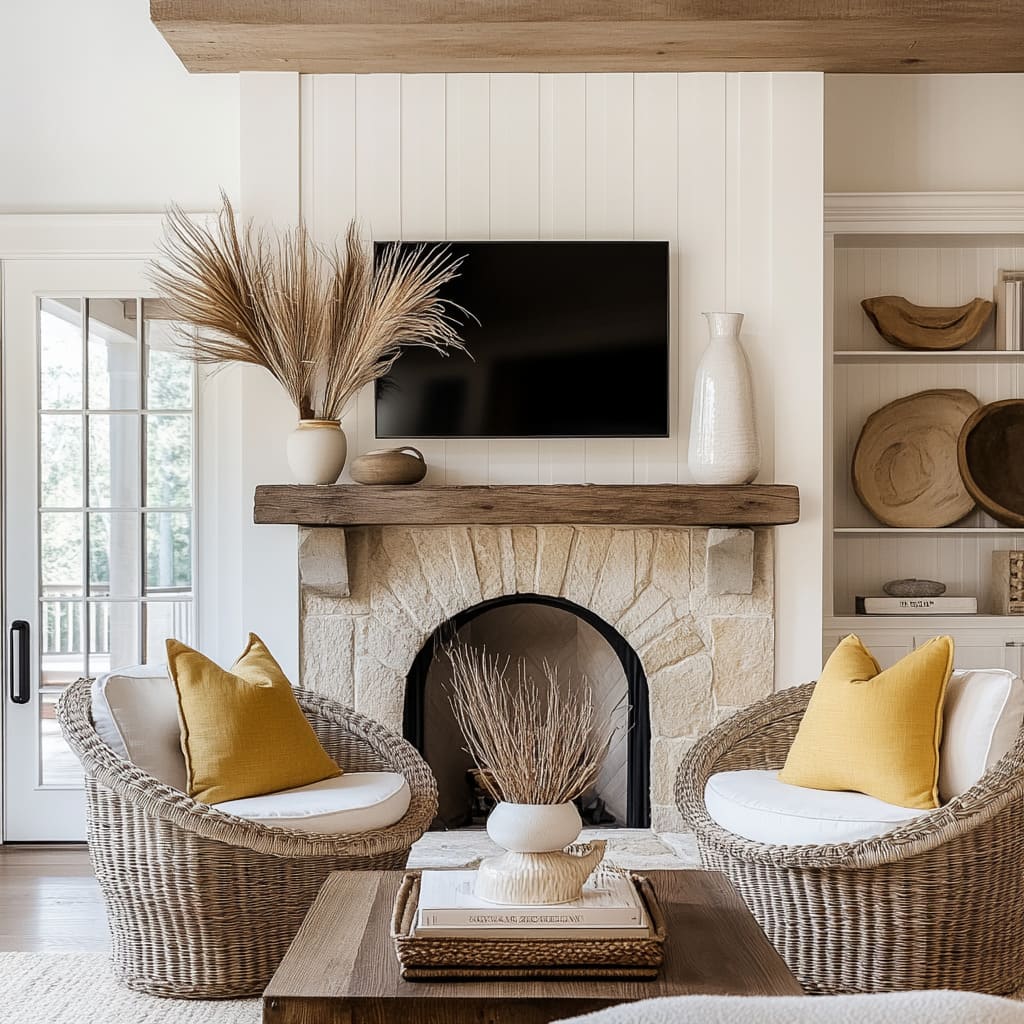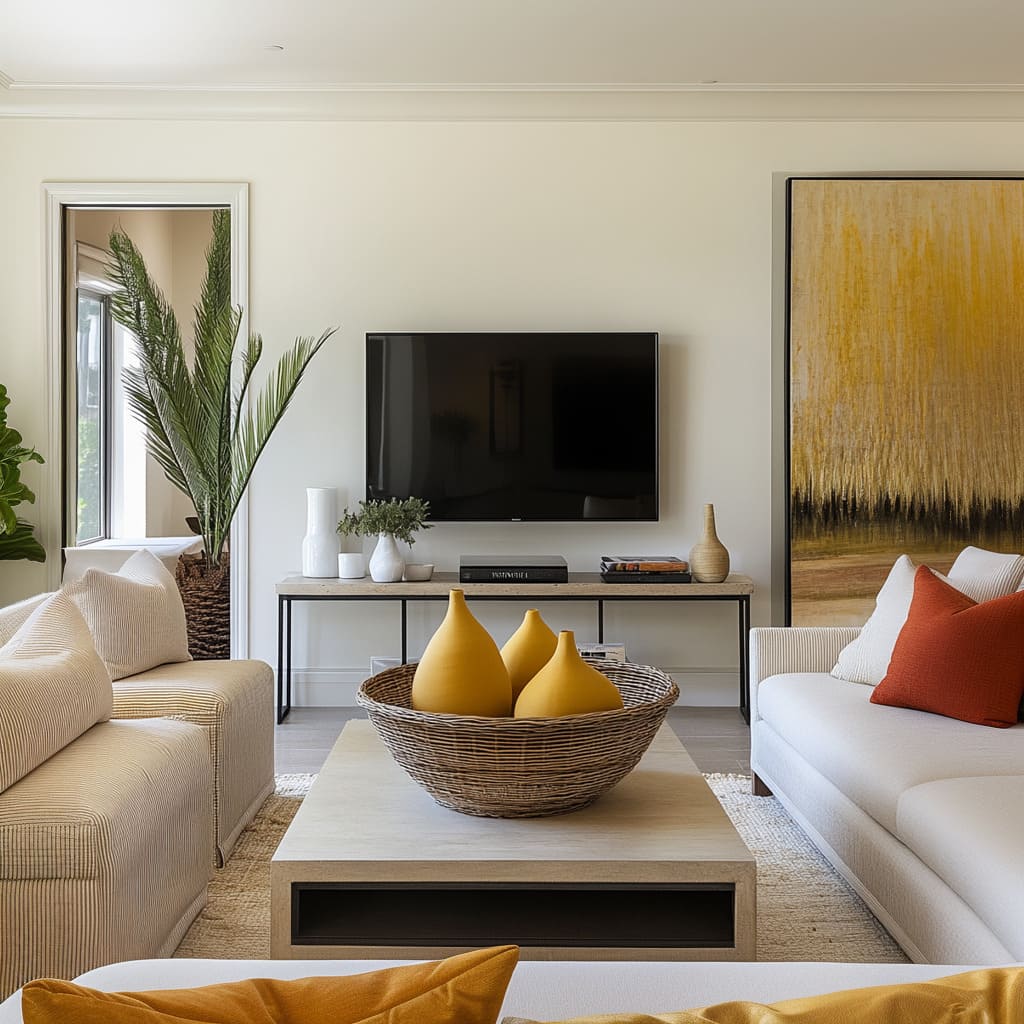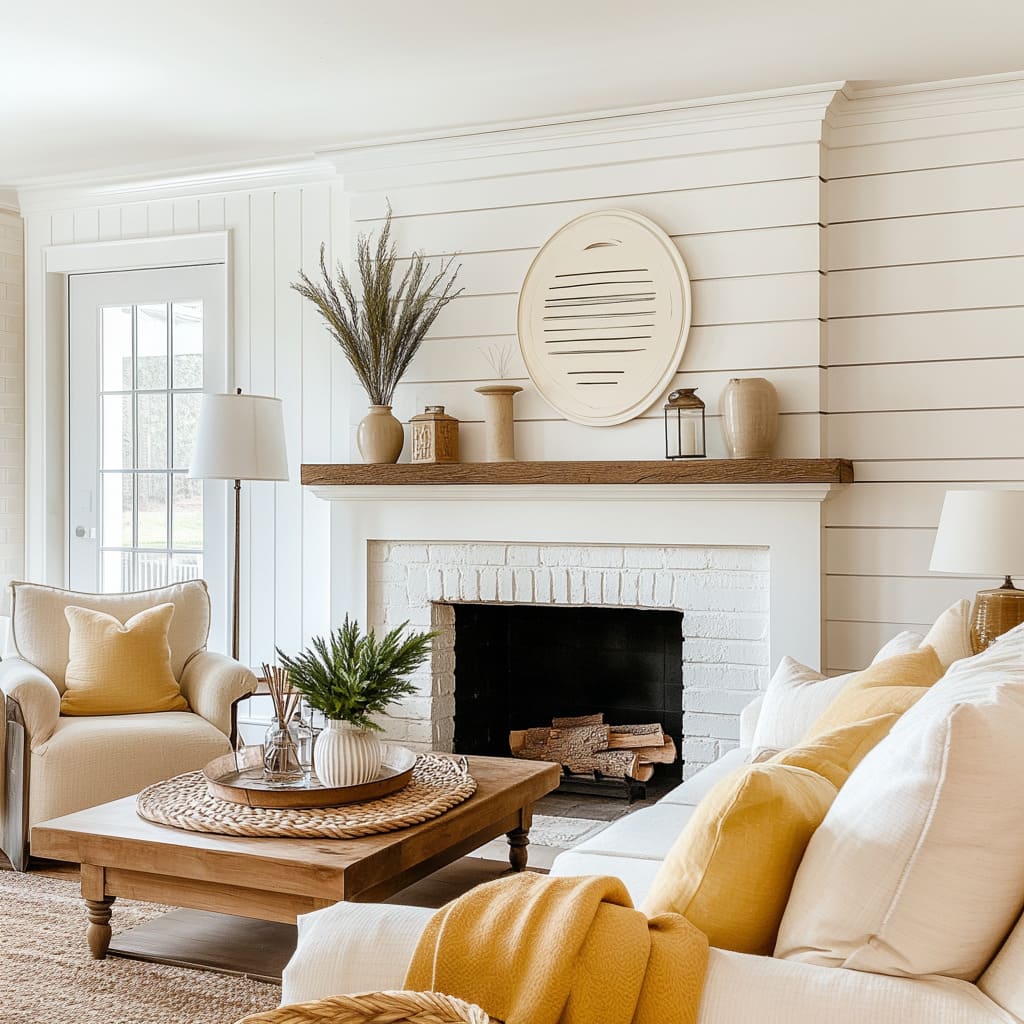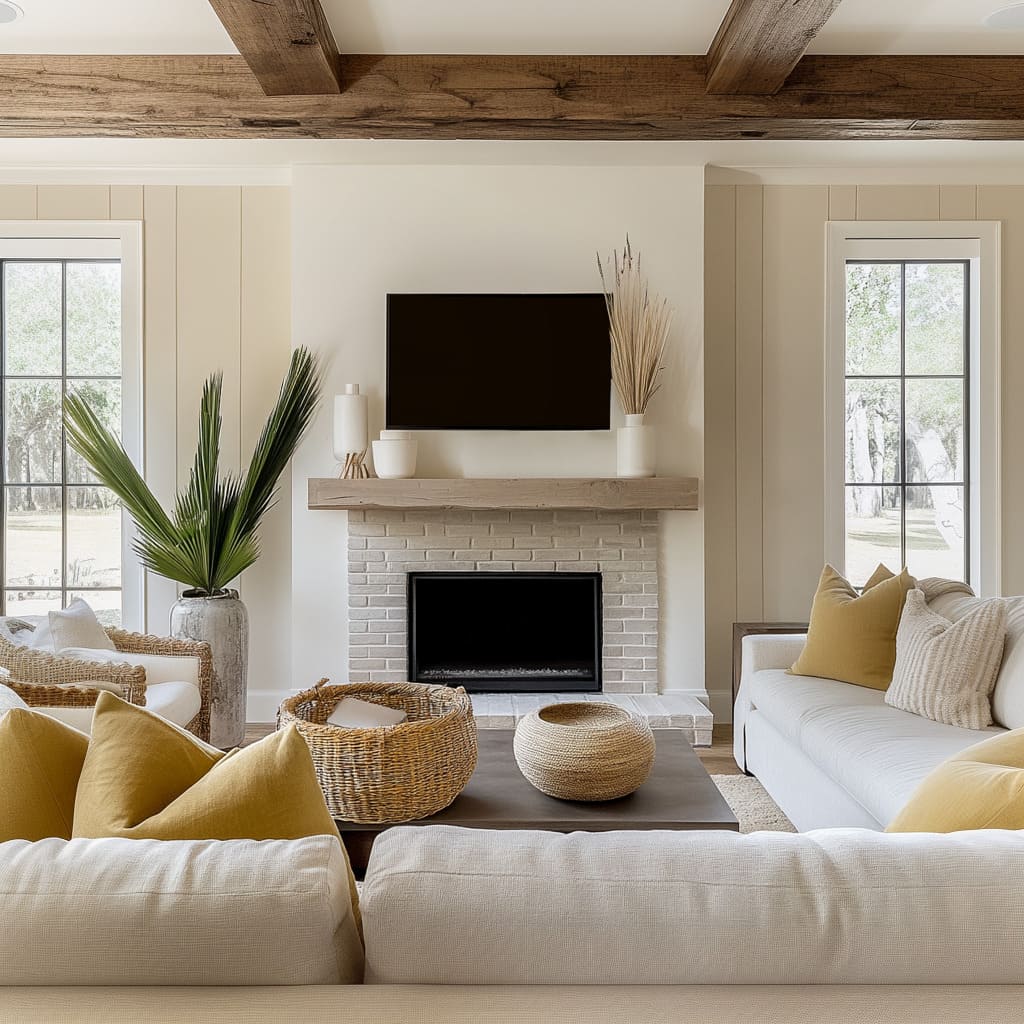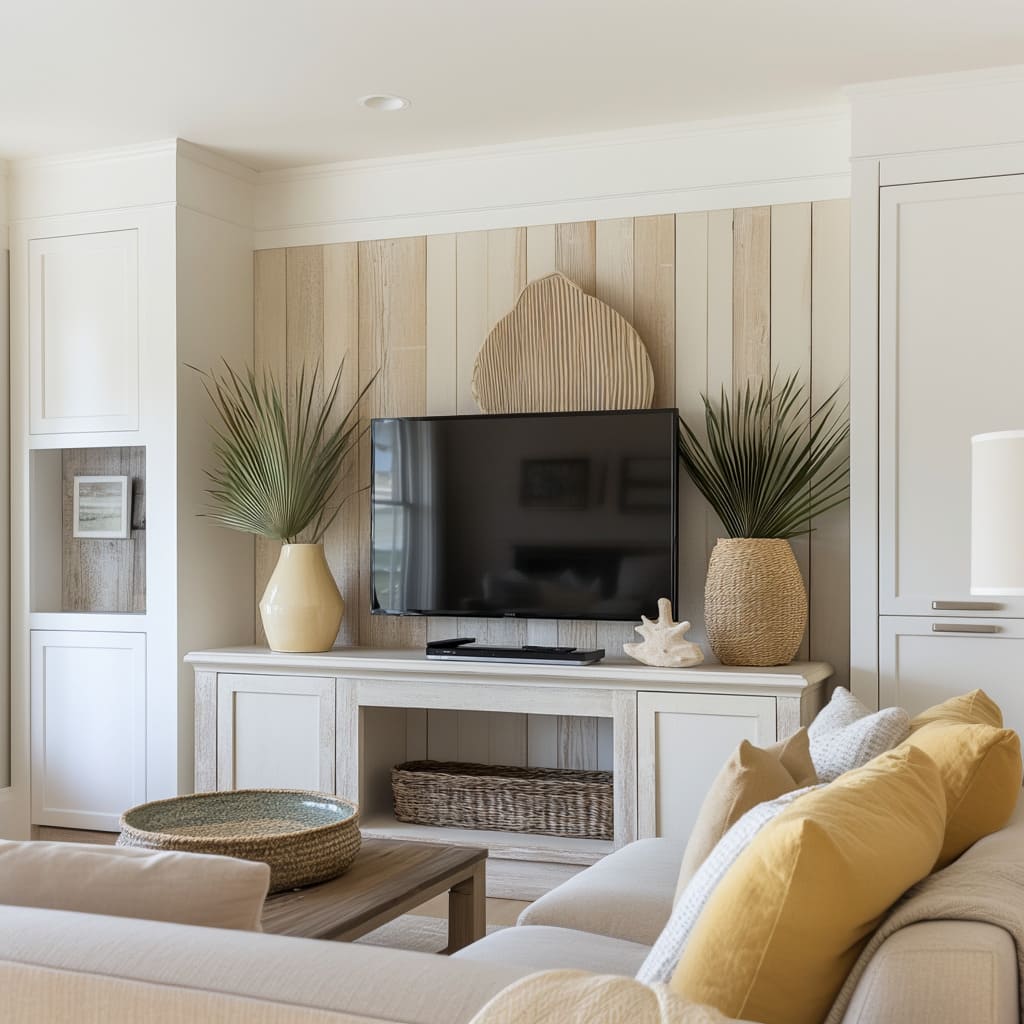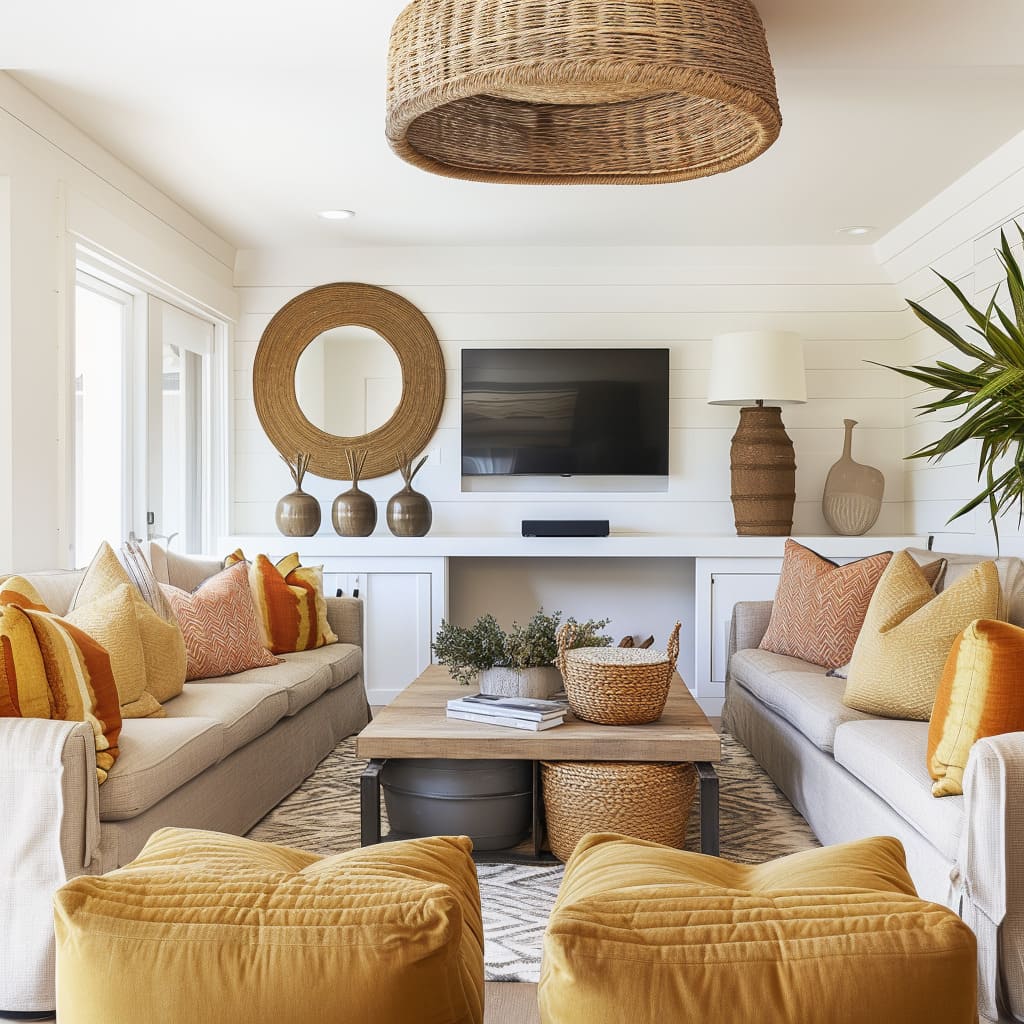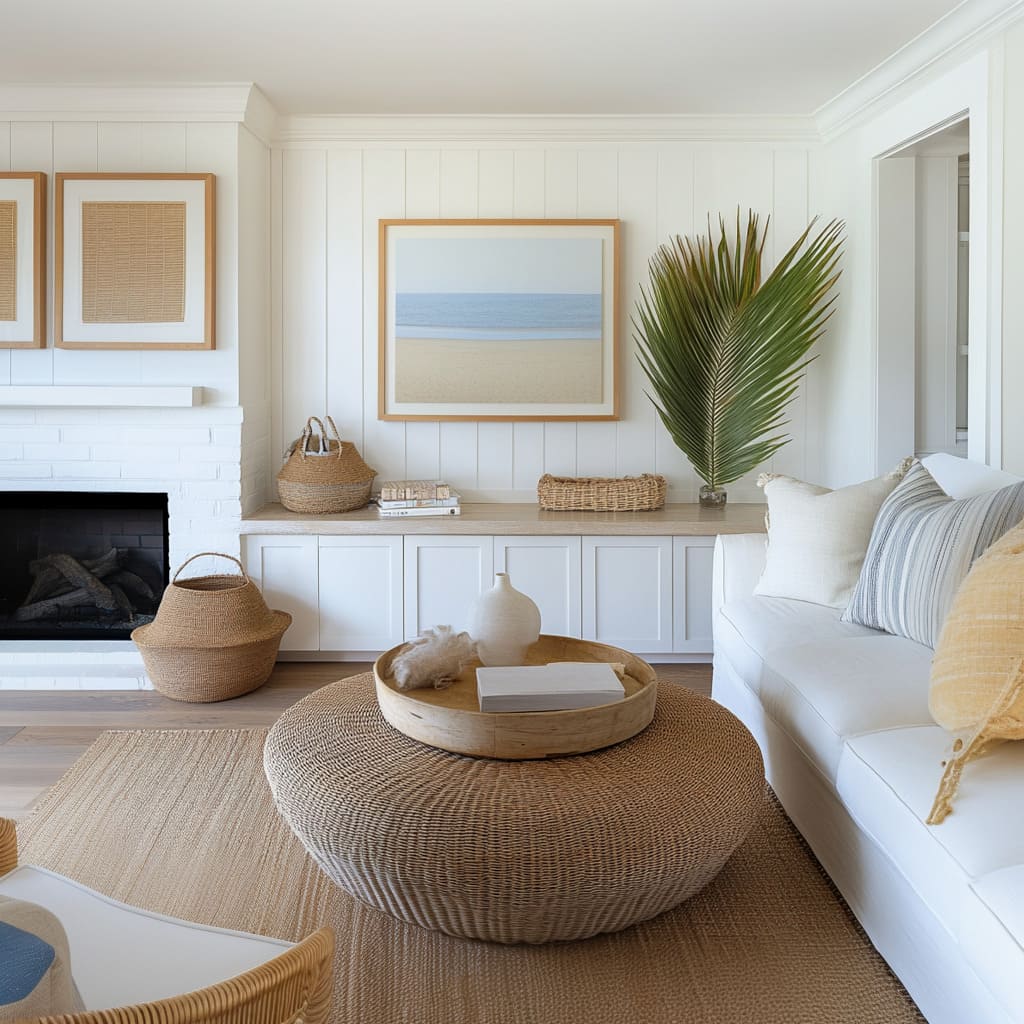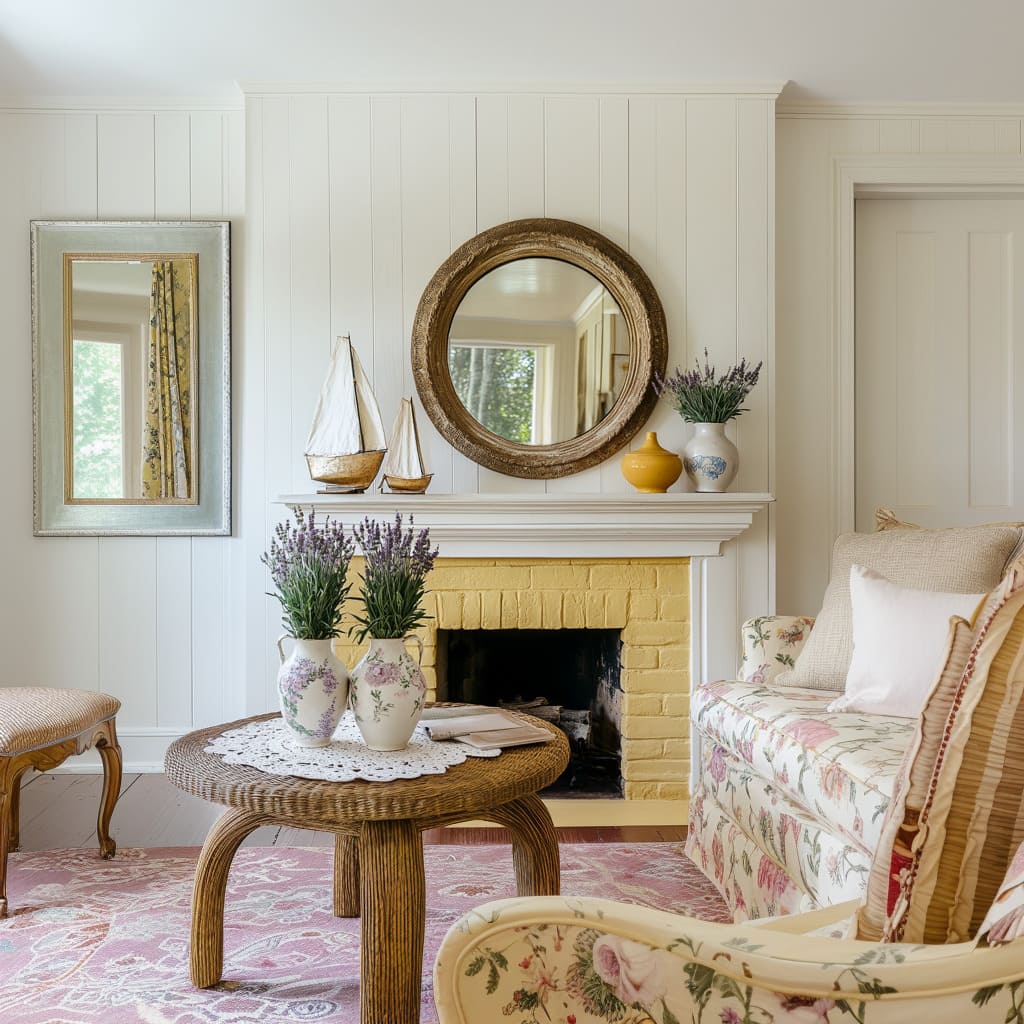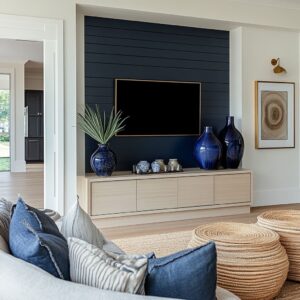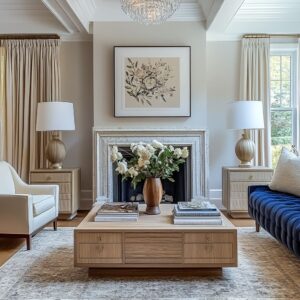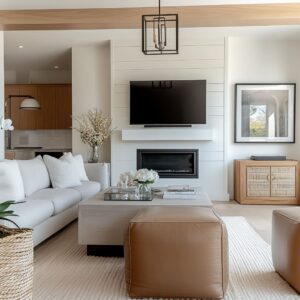Designing yellow living rooms that feel balanced and inviting is an art form that combines careful planning with an understanding of how color interacts with materials, textures, and light. Yellow is undeniably a vibrant and cheerful hue, but when used incorrectly, it can overpower a space.
This article breaks down how to incorporate this sunny shade into your living room in ways that are both sophisticated and visually stunning. We’ll explore how designers use yellow as an accent color to energize interiors, ensuring it complements rather than competes with the room’s other elements.
Drawing from trends, thoughtful combinations of materials, and expert placement of decor, we’ll uncover how yellow can enhance modern, coastal, farmhouse, or transitional designs. Whether through cushions, artwork, or decor, these ideas show how yellow brings life to neutral palettes without dominating the room.
The key lies in creating harmony—balancing yellow with natural textures, such as woven rattan or soft linens, and combining it with neutral bases like white walls, cream sofas, and light wood floors. By analyzing these design choices in depth, this article offers insights on how to create rooms that feel cohesive yet dynamic, proving that yellow accents can be striking without taking over the space.
If you’ve ever wondered how to bring energy into your living room without losing its sense of calm, this deep dive into yellow-infused interiors offers fresh ideas and surprising details. Get inspired by these approaches to styling your home with bold yet balanced touches of yellow, drawing on design principles that work across different styles and settings.
Design Principles Of Using Yellow in Interior Decorating
Incorporating yellow into interior design requires thoughtful planning to achieve harmony and create an inviting space. When used strategically, yellow can transform a room, adding energy and personality without feeling excessive.
Here, we explore the core design principles behind the effective use of yellow in spaces like a yellow sitting room or other interiors, where this vibrant color plays a supporting yet vital role.
Yellow as a Highlight
Yellow works best as an accent, carefully placed to draw attention without overshadowing the room’s overall design. It often appears in soft furnishings, such as cushions or throws, and decor items like vases or poufs, creating pockets of brightness that feel intentional.
For example, a living room with a neutral sofa adorned with yellow cushions immediately becomes more dynamic without overwhelming the senses. Similarly, a piece of artwork featuring shades of yellow can anchor the room and tie in smaller yellow elements placed elsewhere.
This strategic use of yellow also keeps the space adaptable. Soft furnishings and decor items are easy to change, allowing homeowners to update the room seasonally or when trends evolve.
In many cases, this flexibility allows yellow to shine in the moment but remain non-permanent, making it a practical choice for interiors.
Balance Through Repetition
Consistency in color placement is a subtle yet powerful design tactic. By repeating yellow elements in various parts of the room, the space feels cohesive rather than disjointed.
For instance, a pair of yellow cushions on a sofa might be balanced by a small yellow vase on the mantel, and perhaps a pouf with yellow undertones tucked neatly near a coffee table. This repetition does more than provide visual balance—it guides the eye across the room, encouraging a sense of flow.
In a yellow accents for living room setting, this approach can subtly connect different zones, such as a seating area and a reading nook, creating a unified look that feels thoughtful and intentional.
Neutral Base for Contrast
The most successful yellow-accented interiors often feature neutral backdrops that allow the vibrant color to pop. White or beige walls, soft gray upholstery, and light wood floors provide a quiet canvas where yellow can take center stage without competing with other elements.
This neutral foundation also enhances the versatility of yellow accents, ensuring they feel fresh rather than overpowering. For example, in a room with white shiplap walls and a pale wood coffee table, yellow cushions or a bright ceramic vase offer just the right amount of contrast to energize the space.
The neutrality prevents the design from becoming too busy, maintaining a sense of calm while allowing yellow to shine.
Proportional Use of Accents
Proportion plays a critical role in how yellow is perceived within a room. Designers often use small pops of yellow in relation to larger areas of neutral tones to maintain balance.
For example, a single large yellow cushion on a sofa might be paired with smaller yellow accessories on a side table or bookshelf. This thoughtful scaling ensures that yellow feels vibrant and playful without dominating the overall palette.
Additionally, larger pieces, such as a yellow pouf, are often balanced by surrounding them with softer, muted tones. This helps maintain harmony while giving the accent color room to breathe.
By carefully managing the proportion of yellow elements, these designs feel cohesive and grounded rather than chaotic.
Yellow’s Role in Atmosphere
Yellow is often associated with warmth and positivity, making it a natural choice for living spaces. However, its role goes beyond simply brightening a room.
When used effectively, yellow can act as a mood enhancer, creating spaces that feel both inviting and sophisticated. For instance, pairing yellow with natural textures like woven rattan or jute can evoke a relaxed, organic vibe.
Alternatively, combining it with polished metal or glass can lend a more contemporary edge. This adaptability allows yellow to work in a variety of styles, from modern coastal to transitional farmhouse, ensuring it always feels at home in the design.
Insights on Placement and Pairing
Where yellow is placed in a room is just as important as how it is used. In many of these interiors, yellow accents are positioned in areas that naturally catch the eye—on cushions in the center of the seating area, in artwork at eye level, or on mantels as part of curated vignettes.
This deliberate placement ensures maximum impact while maintaining balance with the room’s other features. Pairing yellow with complementary colors like deep greens, soft grays, or muted blues creates depth and contrast, allowing the accents to feel integrated rather than isolated.
These combinations also soften yellow’s intensity, making it more versatile and approachable. Through these principles, yellow transforms from a bold, challenging color into a flexible and impactful tool for enhancing interiors.
By focusing on balance, contrast, and placement, designers have shown how yellow can breathe life into a room without overwhelming its charm.
Decor and Materials
Thoughtfully chosen decor and materials play a crucial role in making yellow accents shine within a living room setting. By balancing boldness with subtlety, these design elements create visually appealing and harmonious interiors.
Each aspect of the room, from furniture to accessories, is curated to emphasize yellow without overwhelming the space. Below, we explore how these elements come together and contribute to cohesive designs, offering inspiration for those seeking creative yellow living room decor ideas.
Furniture: Neutral Foundations with Character
The furniture in these spaces often features a foundation of neutral tones such as off-white, beige, or soft cream. Sofas are upholstered in versatile shades that create a calming backdrop, allowing yellow accents to stand out.
Their designs range from classic transitional forms with clean lines to modern, minimal styles with slightly curved edges, adding softness to the room. Coffee tables often become statement pieces themselves, featuring materials such as warm-toned wood, metal, or even live-edge slabs.
Rustic, natural forms of wood coffee tables complement the sunny accents while adding a touch of organic charm. Meanwhile, modern designs use sleek finishes to emphasize contrast and balance.
The decor on these tables, often arranged in small clusters, is purposefully chosen to align with the overall palette and yellow highlights.
Textiles: Energizing Yet Balanced
Cushions and throws are where yellow’s vibrancy frequently takes center stage. These textiles are not only about color but also texture and pattern.
Geometric designs, stripes, or even bold animal prints bring an element of energy, particularly in rooms that lean toward a modern or eclectic aesthetic. Paired with neutral sofas, they create a vibrant focal point without feeling chaotic.
Rugs often serve as an anchor, grounding the overall arrangement while providing texture. Neutral tones like beige or light gray dominate here, with subtle patterns that blend seamlessly with the rest of the room.
This approach ensures that yellow pops but does not compete with the foundational elements, such as seating and tables.
Decor and Accessories: Small Details, Big Impact
Accessories are an integral part of these living rooms, as they subtly reinforce the color scheme. Vases in yellow tones—crafted from ceramic, glass, or textured materials— often serve as accent points on coffee tables, mantels, or shelves.
These are sometimes grouped with other neutral decor pieces, creating layers of interest without overcrowding the design. Greenery is another essential feature.
Natural planters housing lush plants not only add vibrancy but also serve as a grounding force to balance the room’s bright accents. They complement the yellow decor by introducing a touch of freshness and biophilic appeal.
Artwork is another common choice for weaving yellow into the room. Wall art often pairs yellow with complementary shades like green or blue, blending harmoniously into the broader palette while reinforcing the design’s focal points.
Lighting: Bringing It All Together
Lighting plays an understated yet impactful role in creating a light yellow living room. Large windows or glass doors flood the space with natural light, amplifying the bright, cheerful atmosphere that yellow inherently brings.
These open designs are particularly effective in highlighting the interplay between sunlight and yellow accents, making the space feel airy and inviting. For artificial lighting, minimalist table lamps or standing lights often feature soft, diffused shades.
These are carefully chosen not to overpower the yellow tones but to enhance them. Warm light bulbs are typically preferred, as they mirror the warmth of yellow accents and create a cohesive ambiance throughout the room.
Thoughtful Use of Materials
Natural materials like rattan, wicker, and wood are consistently featured in these designs. They provide texture and contrast while subtly reinforcing the organic, inviting qualities of the space.
For example, a woven pouf in a yellow shade might sit near a natural wood coffee table, combining function and style. This thoughtful pairing ensures that every material works together to enhance the room’s overall aesthetic.
Layering for Depth and Balance
What sets these designs apart is their ability to layer elements strategically. The neutral foundation of sofas and walls provides a clean slate, while yellow accents are carefully dispersed to maintain visual balance.
By layering different materials—soft fabrics, sleek metals, and natural wood—the rooms achieve depth and a sense of harmony. These principles offer a masterclass in designing with yellow.
The key is in thoughtful placement, complementing tones, and a balance of bold and neutral elements, ensuring the space feels inviting, cohesive, and full of character.
Trends
Yellow accents in interior design are at the forefront of several notable trends that resonate with modern preferences. These trends showcase how thoughtfully incorporating yellow can create visually appealing and practical living spaces.
From organic materials to a bold yet balanced use of color, these approaches reflect the changing tastes of homeowners who want spaces that are both stylish and functional. Let’s delve into these influential themes and their role in shaping contemporary interiors, offering inspiration for those seeking living room ideas with yellow accents.
Earthy and Organic Themes
The prominence of natural materials like rattan, jute, and wood is a defining feature in many of these spaces. This aligns seamlessly with the growing popularity of biophilic design, which emphasizes connecting interiors with nature.
Materials such as woven rattan poufs, jute rugs, and raw wood coffee tables not only add texture but also exude warmth and authenticity. These earthy elements work particularly well with yellow, as the color itself evokes a sense of sunshine and vitality, enhancing the organic aesthetic.
This trend also emphasizes the sustainability aspect of interior design, as many of these materials are eco-friendly and durable. By using these natural textures alongside yellow accents, designers achieve an inviting balance that feels rooted in the environment while remaining timeless and adaptable.
Bold Yet Subtle Color Accents
The use of yellow as an accent color exemplifies the rising trend of incorporating bold hues into predominantly neutral interiors. In these designs, yellow is neither overpowering nor too sparse—it’s just enough to inject personality into the room.
Whether through cushions, vases, or artwork, yellow accents draw attention to specific areas without overwhelming the overall scheme. This approach reflects a broader shift toward interiors that prioritize calmness but aren’t afraid to showcase individuality.
By adding a controlled dose of vibrancy, the spaces feel modern and dynamic. This strategy is particularly evident in a modern yellow living room, where neutral bases like beige or gray allow the yellow accents to pop, creating an energizing yet cohesive atmosphere.
Mixed Materials for Depth
An interesting trend that stands out in these living rooms is the deliberate use of mixed materials. Combining smooth ceramics with woven textures or pairing rustic wood finishes with sleek metal frames creates depth and visual interest.
For example, a ceramic vase in a soft yellow tone might be juxtaposed with a wicker basket, while a glass lamp sits on a live-edge wood side table. These combinations prevent the design from feeling one-dimensional, encouraging layers of texture and tactile variety.
The interplay between materials helps amplify the impact of yellow accents, making them feel intentional and integrated into the space rather than added as an afterthought.
Functionality and Flexibility
Yellow accents in these rooms often take the form of removable and replaceable decor. Pillows, throws, and smaller accessories like vases are frequently highlighted as the primary carriers of the yellow theme.
This flexibility aligns with a trend toward adaptable interiors, where elements can evolve to match changing tastes or seasons. By focusing on items that can be swapped out easily, these designs cater to the modern homeowner’s desire for versatility.
This also ensures that the space remains fresh and relevant over time. A yellow throw on a neutral sofa can be replaced with a muted tone during colder months, showcasing how adaptable these spaces are to personal preferences and external factors.
Practical Yet Inviting Lighting
Lighting also plays a key role in bringing these trends together. Large windows and open layouts are common features, emphasizing natural light to complement yellow accents.
The sunlight highlights the vibrancy of yellow decor while enhancing the organic textures in the room, creating a warm and inviting environment. In terms of artificial lighting, minimalist fixtures such as floor lamps or pendant lights are strategically placed to avoid detracting from the decor.
This subtlety ensures that the focus remains on the carefully chosen yellow highlights while maintaining functionality and balance in the room.
Modern Inspirations
These trends collectively highlight how yellow can be a transformative addition to interior design when used thoughtfully. By pairing bold accents with organic elements and a neutral base, these spaces strike a harmonious balance that feels both contemporary and welcoming.
The flexibility and adaptability of yellow accents also make them suitable for a variety of styles, from cozy traditional settings to sleek and modern yellow living room designs. Ultimately, these trends show how yellow can serve as a powerful yet understated tool in creating interiors that feel fresh, dynamic, and full of character.
The careful integration of materials, lighting, and adaptable decor demonstrates how this cheerful hue can elevate a space without dominating it, ensuring it remains timeless and tailored to individual preferences.
Decorating Combinations
Designing interiors with yellow accents requires more than a simple choice of decor. The subtleties in placement, combinations, and relationships between colors and textures elevate these rooms from being merely attractive to truly intentional and harmonious spaces.
From the strategic use of yellow to its interplay with other design elements, the following insights delve into how this vibrant hue transforms interiors. Whether browsing through pictures of yellow living rooms or observing the elegance of a white yellow living room, these principles show the depth of thought in creating balance and cohesion.
Yellow as a Harmonizer
In spaces featuring bold architectural details or vivid artwork, yellow often acts as the bridge between diverse elements. For instance, a room with a striking painting in mixed tones might use yellow cushions or vases to highlight the warm tones within the artwork.
Similarly, wooden furniture or accents with rich earthy textures are complemented by yellow, which picks up on the underlying warmth in the materials. Rather than allowing bold elements to compete for attention, yellow harmonizes these features, drawing the eye across the room with a natural rhythm.
The effect is a unified design that feels cohesive without appearing overly coordinated. This approach transforms potential visual dissonance into an intentional composition.
Interplay with Greenery
One of the most striking insights is how yellow accents are paired with greenery. Whether it’s a vase filled with lush tropical leaves or a corner anchored by a tall indoor plant, the combination of green and yellow creates a fresh and invigorating effect.
This pairing subtly mirrors the colors found in nature, evoking meadows, gardens, or sunlit landscapes. This relationship between green and yellow goes beyond simple aesthetics; it also amplifies the organic feel of the room.
Greenery softens the intensity of yellow while simultaneously enriching its warmth, making the space feel vibrant but not overly energized. The balance between these tones offers a visual connection to nature without being overtly thematic.
Strategic Placement for Maximum Impact
The placement of yellow accents in these living rooms is highly deliberate. Designers ensure that these pops of color are located where the eye naturally lands.
For instance, yellow cushions are placed in the center of a seating area, immediately drawing attention and framing the conversation zone. Artwork at eye level often incorporates yellow tones, ensuring that the color isn’t confined to the lower half of the room.
This vertical distribution creates balance, encouraging the eye to travel across the space. Such thoughtful placement ensures that yellow accents make an impact without overwhelming the overall design.
Contrast Without Clutter
One of the most important principles in these designs is restraint. While yellow is a bold and attention-grabbing color, it’s used sparingly and strategically to avoid cluttering the visual field.
A well-placed pouf, a single vase, or a cluster of cushions might be all that’s needed to achieve the desired contrast. The careful curation of yellow elements prevents the room from feeling overly busy, maintaining a sense of calm and focus.
This balance between boldness and subtlety ensures that yellow complements the design rather than competing with it. By showing restraint, these interiors achieve a polished and sophisticated look.
The Play of Warmth and Coolness
A particularly intriguing insight is how yellow interacts with cooler tones in these living rooms. Often, yellow is paired with shades like gray or blue to create a dynamic interplay of temperatures.
For example, a white sofa with gray cushions may be accented with a single yellow throw, while a painting that includes blue tones might incorporate a small streak of yellow. This juxtaposition heightens the impact of yellow, as its warmth feels even more vibrant against cooler tones.
The interplay creates a layered, engaging environment where each color enhances the other. It’s a delicate balance that adds dimension and depth to the room, making the space feel alive and welcoming.
Insights from Pictures and Real-Life Applications
Reviewing pictures of yellow living rooms, it becomes evident that these spaces are designed with a keen eye for both detail and the overall mood. In a white yellow living room, the neutrality of white walls and furnishings provides the perfect canvas for yellow’s brightness.
This approach ensures that yellow accents remain the focal point, standing out without overwhelming. By combining design principles like harmony, placement, and contrast with creative pairings of colors and materials, these living rooms showcase how yellow can transform an interior.
The balance achieved in these designs offers not only aesthetic appeal but also practical insights into how to create interiors that feel intentional, thoughtful, and inspiring.
Ideas and Takeaways
The thoughtful integration of yellow accents in living rooms highlights how even a bold hue can feel harmonious when applied with precision and creativity. The versatility of these designs offers a wealth of inspiration for crafting interiors that are vibrant yet grounded.
From scalability to adaptability, the ideas below showcase practical approaches to incorporating yellow without overwhelming the space.
Scalability: Yellow in Spaces of All Sizes
A significant takeaway is the scalability of yellow accents across various room sizes. In compact spaces, a few strategically placed yellow elements can brighten the area, creating energy without overpowering.
For instance, a single yellow cushion or a small ceramic vase placed on a side table can inject color while maintaining a sense of openness. In larger living rooms, yellow can take on a more prominent role.
Bold features such as an oversized pouf or a striking yellow artwork act as focal points while still feeling balanced within the broader design. The adaptability of yellow’s intensity ensures it can suit any space, making it a flexible option for diverse yellow living room design ideas.
Architectural Features as Frames
The use of architectural features to frame yellow accents is a clever strategy that adds depth and visual interest. Fireplaces, for example, often become the backdrop for small pops of yellow—whether it’s a vase on the mantel or artwork above the hearth.
Built-ins and shelving units also play a role, offering a neutral framework that allows yellow decor to shine. This approach is particularly effective in rooms with minimalist or neutral palettes, as the contrast between the yellow accent and the simplicity of the architectural element draws the eye.
It’s a subtle yet impactful method of integrating yellow without overwhelming the space.
Artwork: Dual Purpose in Design
Art is frequently used as a tool to introduce yellow into a room, but its role goes beyond mere decoration. Yellow within artworks often serves as a connecting thread, tying together various elements such as textiles, materials, and other accent colors.
For example, a painting featuring a yellow motif can harmonize with a nearby cushion or pouf, creating a sense of cohesion. This dual-purpose approach makes art an essential part of many yellow color combinations for living room interiors, ensuring that color is distributed thoughtfully and effectively throughout the space.
Seasonal Adaptability: Effortless Refreshes
One of the standout features of these designs is their adaptability. Most yellow accents are removable and interchangeable, making it easy to update the space as seasons or personal preferences change.
During spring and summer, yellow’s brightness can complement the season’s natural light, while in autumn, it can transition into a warmer, cozier palette. This flexibility allows homeowners to experiment with their interiors without committing to permanent changes.
By simply swapping yellow cushions or throws for accents in a different color, the entire mood of the room can shift. It’s a cost-effective and practical approach that resonates with those seeking versatility in their spaces.
Subtle Patterns: Adding Depth and Interest
Patterns are another tool frequently used to enhance the impact of yellow accents. Cushions with geometric designs, striped rugs, or textiles featuring subtle prints incorporate yellow in a way that adds texture and depth.
These patterns ensure that the room feels layered and dynamic, avoiding the flatness that can occur with solid blocks of color. The key to this approach lies in balance.
Patterns are kept understated, allowing yellow to take center stage without competing with other elements. This attention to detail ensures that the design remains cohesive and sophisticated.
Takeaways for a Cohesive Interior
The overarching theme in these designs is balance. Yellow accents are used sparingly yet strategically, ensuring that they enhance rather than dominate the room.
Whether it’s through the framing of architectural features, the careful use of artwork, or the interplay with subtle patterns, yellow is always integrated with intention. For those seeking inspiration, these ideas highlight how yellow can transform a living room into a space that feels both lively and harmonious.
By focusing on scalability, adaptability, and thoughtful placement, these designs showcase the endless possibilities of working with this vibrant hue. From modern interpretations to classic inspirations, yellow proves to be a versatile and impactful choice.
Conclusion
The designs explored in this article highlight the transformative impact of carefully chosen yellow accents in living rooms, offering a wealth of inspiration for those seeking to incorporate this vibrant hue. Each space demonstrates a deliberate approach to color balance, seamlessly weaving yellow into neutral foundations to create a sense of harmony and sophistication.
By integrating natural textures like rattan, wood, and soft textiles, these interiors achieve a look that feels fresh, organic, and contemporary. The success of these interiors lies in their ability to reflect modern living needs—flexibility and practicality—while maintaining visual appeal.
Yellow accents, whether in the form of cushions, vases, or carefully selected artworks, remain adaptable, allowing for easy updates to suit seasons or personal tastes. This versatility makes these designs not only beautiful but also functional for everyday life.
These spaces also align with global trends, showcasing the importance of subtle contrasts and natural materials in creating depth and interest. The thoughtful placement of yellow as an accent, often in high-visibility areas like a cushion on a central sofa or a decorative vase on a fireplace mantel, enhances the overall design without overshadowing the rest of the room.
This ensures that the rooms feel cohesive and inviting. The use of yellow also illustrates its ability to complement and amplify other elements, such as greenery or cool blue tones, for a more dynamic visual experience.
These designs offer valuable insights into how color can act as a bridge, harmonizing various textures, materials, and architectural features. They are a testament to the idea that bold colors, when applied with intention, can elevate the design to new heights.
For anyone looking for inspiration, these yellow sitting room ideas are a testament to the timeless appeal of this hue. By using yellow as a supporting player rather than the dominant feature, these spaces capture a perfect balance between vibrancy and tranquility.
The approach showcased here proves that even the smallest accent can bring warmth and life to a room when thoughtfully curated. In essence, these living rooms embody the essence of modern interior design: a blend of beauty, functionality, and adaptability.
Whether it’s a minimalist space with just a touch of yellow or a more eclectic room with layered accents, the lessons from these designs are clear—strategic use of color and texture creates interiors that stand out without overwhelming, making them both visually striking and truly livable.
